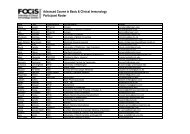Oral Presentations - Federation of Clinical Immunology Societies
Oral Presentations - Federation of Clinical Immunology Societies
Oral Presentations - Federation of Clinical Immunology Societies
You also want an ePaper? Increase the reach of your titles
YUMPU automatically turns print PDFs into web optimized ePapers that Google loves.
S52 Abstracts<br />
Based on H&E and direct IF studies, 34 cases were diagnosed as<br />
MMP. The most common antibody deposited was IgG (90%)<br />
followed by C3 (82%) and IgG4 (71%). Strikingly, IgG4 was the<br />
sole antibody detected in two cases (6%). Conclusion: Our<br />
results suggest that the use <strong>of</strong> monoclonal IgG4 is important in<br />
the diagnosis <strong>of</strong> MMP. We suggest adding monoclonal IgG4 to the<br />
routine panel <strong>of</strong> antibodies used in studies <strong>of</strong> cases suspected to<br />
have MMP to avoid false-negatives.<br />
doi:10.1016/j.clim.2007.03.324<br />
F.111 Immuophenotyping <strong>of</strong> PBL and B.M Markers in<br />
Patients with Leukemia by Flowcytometry<br />
Fereshteh Alesahebfosoul, Academic Member <strong>of</strong> Isfahan<br />
University, Isfahan University Medical School, <strong>Immunology</strong><br />
Department, Isfahan<br />
Introduction: Peripheral blood lymphocytes (PBL) and bone<br />
marrow (B.M.) immunophenotyping is widely used for diagnosis<br />
and prognosis <strong>of</strong> leukemia. Flow cytometry technique provided<br />
facilities to assess the frequency <strong>of</strong> malignant cell population<br />
and the protein expression in each group <strong>of</strong> cells which have<br />
been gated. Method and material: Fresh peripheral blood and<br />
bone marrow <strong>of</strong> patient were collected and tested for following<br />
examination: total white blood cells and leukocyte percentage<br />
rate were determined by H1. Machine: The samples were<br />
treatedwithconjugatedMoAbwithFITCand/orphycoErythrine<br />
and then dual staining <strong>of</strong> cells was performed. The following<br />
monoclonal antibodies were used: CD10, CD19, CD20, CD5,<br />
CD3, CD22, CD7, CD33, anti-HLA DR, and CD13. After direct<br />
staining <strong>of</strong> cell samples, 30,000 cells were analyzed by flow<br />
cytometry. Result and discussion: The results <strong>of</strong> the first case <strong>of</strong><br />
the study were WBC=780 and LUC=2.2%, CD7=60%, CD=57%,<br />
CD5=56%<strong>of</strong>thelymphocytepopulation<strong>of</strong>peripheralblood.But<br />
the same markers in bone marrow sample were determined for<br />
D7=5%, CD3=5%, and CD5=6.5%. The results <strong>of</strong> the second case<br />
<strong>of</strong> the study were CD19=90%, CD20=89%, CD22=82%, and<br />
CD5=95% <strong>of</strong> the lymphocyte population <strong>of</strong> peripheral blood. In<br />
addition the same markers in bone marrow samples were<br />
determined for CD19=76%, CD20==85%, CD22=75.9%, and<br />
CD5=93%. HLA-DR marker was shown to be over 80% in both<br />
peripheral blood and bone marrow for this case. The result <strong>of</strong><br />
cell counting for the third case <strong>of</strong> the study showed WBC=4800<br />
and LUC=6.3%, CD19=41.5%, CD20=29.5%, CD22=39% and<br />
CD5=43.12%, CD3=40.3%, and CD7=41.1% in peripheral blood.<br />
But the same markers from bone marrow sample were<br />
determined for CD19=85.6%, CD22=81.2% and CD5=2.08%<br />
and CD3=1.88%. The results <strong>of</strong> this study show that the<br />
lymphocyte protein expression in leukemic samples is the value<br />
in diagnostic and classification <strong>of</strong> leukemia.<br />
doi:10.1016/j.clim.2007.03.325<br />
F.113 An All-Human Culture Model Supporting<br />
Human B Lymphopoesis<br />
Mercy Kagoda, Graduate Research Assistant/Student, Loma<br />
Linda University School <strong>of</strong> Medicine Department <strong>of</strong> Pathology<br />
and Human Anatomy, Loma Linda, CA, Yasmin Parrish,<br />
Research Specialist II, Childrens Hospital Los Angeles Research<br />
<strong>Immunology</strong> Bone Marrow Transplant, Los Angeles, CA,<br />
Jaqueline Rogerio, Post Doctoral Fellow, Childrens Hospital Los<br />
Angeles Research <strong>Immunology</strong> Bone Marrow Transplant, Los<br />
Angeles, CA, Ineavely Baez, Senior Research Assistant, Loma<br />
Linda University School <strong>of</strong> Medicine Department <strong>of</strong> Pathology<br />
and Human Anatomy, Loma Linda, CA, Qian-Lin Hao, Research<br />
Specialist IV, Childrens Hospital Los Angeles Research<br />
<strong>Immunology</strong> Bone Marrow Transplant, Los Angeles, CA, Lora<br />
Barsky, Flow Technologist, Childrens Hospital Los Angeles<br />
Research <strong>Immunology</strong> Bone Marrow Transplant, Los Angeles,<br />
CA, Ewa Zielinska, Flow Technologist, Childrens Hospital Los<br />
Angeles Research <strong>Immunology</strong> Bone Marrow Transplant, Los<br />
Angeles, CA, Monika Smogorzewska, Flow Technologist,<br />
Childrens Hospital Los Angeles Research <strong>Immunology</strong> Bone<br />
Marrow Transplant, Los Angeles, CA, Kimberly Payne, Assistant<br />
Pr<strong>of</strong>essor, Loma Linda University School <strong>of</strong> Medicine<br />
Department <strong>of</strong> Pathology and Human Anatomy, Loma Linda,<br />
CA<br />
Traditionally, nonfetal models <strong>of</strong> human B cell development<br />
have been based on co-culturing hematopoietic stem cells<br />
(HSCs) from cord blood (CB) and bone marrow (BM) on murine<br />
stromal cell lines. Here we describe the progressive replacement<br />
<strong>of</strong> murine components to generate a totally human<br />
culture model that supports human hematopoiesis, including B<br />
cell development. First, we replaced murine stromal cell lines<br />
with primary human BM stroma, next human serum was<br />
substituted for nonhuman sera. It has been reported that<br />
human B cell precursors selectively interact with CD10+ stromal<br />
cells during in vivo B cell development. In our cultures, human<br />
stroma express CD10 and secrete IL-7 at levels comparable to<br />
primary murine BM stroma. We found that human stroma bind<br />
IL-7 independently <strong>of</strong> the IL-7 receptor thereby having the<br />
potential for presenting IL-7 to developing B cell precursors.<br />
This is important as we have recently shown that IL-7 expands<br />
human B cell precursors by ∼50 fold and that IL-7 is essential for<br />
production <strong>of</strong> B cells from HSCs in adult human BM. While<br />
human stroma in our cultures express the human pre-BCR<br />
ligand, galectin-1 (Gal-1), the presence <strong>of</strong> Gal-1 was not<br />
required for IL-7-induced expansion <strong>of</strong> human B cell precursors.<br />
HSCs in co-cultures with human stroma and serum showed a<br />
generative capacity for CD19+ and CD19− progeny that was at<br />
least equal to that seen on murine stroma with nonhuman sera.<br />
Planned experiments will assess the ability <strong>of</strong> this culture model<br />
to support primary B cell malignancies.<br />
doi:10.1016/j.clim.2007.03.326<br />
F.114 Expression <strong>of</strong> CD3 and T Cell Receptor (TCR)<br />
on a Minor Population <strong>of</strong> Human CD14 Positive Cells<br />
Daron Forman, Senior Scientist, Tolerx, Cambridge, MA,<br />
Michael Rosenzweig, Senior Director <strong>of</strong> Preclinical<br />
Research, Tolerx, Cambridge, MA, Lou Vaickus, Chief<br />
Medical Officer, Tolerx, Cambridge, MA<br />
The TCR associates with CD3 polypeptides including CD3<br />
delta, gamma, epsilon, and zeta. It was commonly believed<br />
that TCR and CD3 expression occur exclusively on T cells.<br />
Recently however, TCR expression was reported on a minor<br />
population <strong>of</strong> both mouse and human neutrophils indicating




